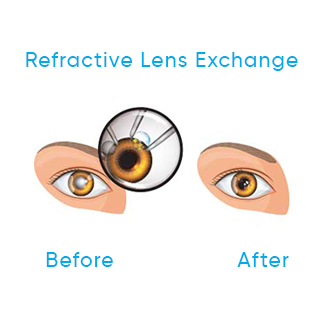What Is
Refractive Lens Extraction?
If you have presbyopia or suffer from severe farsightedness (hyperopia), you may not be a good candidate for some of the more common corrective procedures like PRK, LASIK or phakic IOL surgery. Refractive lens exchange (RLE) to the rescue.
Also referred to as clear lens exchange or refractive lensectomy, RLE is a surgical procedure that involves removing the natural lens of the eye and replacing it with an artificial intraocular lens (IOL). This might sound like a similar procedure to cataract surgery. That’s because it is. RLE is essentially the same procedure without the presence of a cataract. Like LASIK and other modern eye surgeries, refractive IOLs have allowed millions of patients to achieve 20/20 vision or better without the need for corrective lenses.
RLE Procedure – What’s Involved In Treatment?


As mentioned, the procedure itself is essentially identical to cataract surgery and involves removing the natural lens of the eye and replacing it with one of three IOL varieties:
- 1. Monofocal IOL
- 2. Multifocal IOL
- 3. Toric IOL
- Monofocal IOLs are the most basic option, providing clear vision for a single distance type (near, intermediate or far).
- Multifocal IOLs are premium lenses that provide correction across multiple distances at fixed points.
- Toric intraocular lenses (IOLs) are the procedure of choice to correct corneal astigmatism.
To perform RLE, your surgeon will apply numbing eye drops that will minimize any discomfort. If you are have IOLs implanted in both eyes, you will not be able to have treatment on the same day. Each eye must be treated separately one or two weeks apart.
Recovering From Refractive Lens Extraction (RLE)
You will not be able to drive yourself home after treatment, meaning you will need to arrange a ride after your surgery. Most people are able to resume normal activity (including driving) within a week of RLE.
Improved vision should be immediate for most patients, but total corrective benefits may not be fully realized for several weeks. During this recovery period, it’s not uncommon for patients to experience issues like glare, halos, blurred vision and mild discomfort as the eye heals.
Benefits Of Refractive Lens Extraction (RLE)
Refractive lens exchange may benefit you in a number of potentially life-changing ways.
If you don’t have cataracts but you do have severe myopia (nearsightedness) or hyperopia (farsightedness), your surgeon has probably informed you that you are not a good candidate for LASIK. But thanks to options such as RLE, you too can enjoy the transformative benefits of refractive surgery. Similarly, if you are not a good candidate for LASIK due to thin corneas, RLE is a viable alternative.
Surgery to implant refractive IOLs also offers the following benefits:
- Quick recovery
- Doesn’t alter corneal thickness (unlike laser vision correction) and therefore eliminates some potential complications
- No need for cataract surgeryin eye(s) treated with RLE in the future
- No risk of losing corrective effect (unlike laser vision correction)
- Can correct presbyopia(age-related farsightedness)
Are You A Candidate?
You must be 21 years old or older to be considered a good candidate for RLE. In addition, you must have stable vision for the six months leading up to your procedure, and you must have healthy eyes, with no history of eye disease. Finally, it is important that you understand and accept the risks associated with procedures involving the implantation of refractive IOLs.
Many experts believe that the best candidates for refractive lens exchange are people with moderate to high farsightedness, and those with farsightedness who are over age 45 and have presbyopia (the latter have a lower risk of retinal detachment than people with high myopia).
If you have a condition that is more readily correctable with LASIK or PRK, your doctor will likely urge you to consider these more conservative alternatives.



